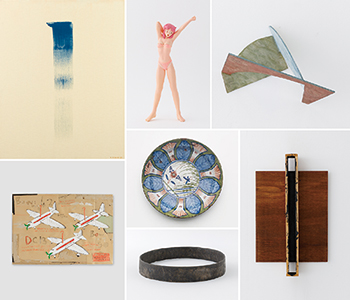What Is the Relationship Between Ceramics and Contemporary Art?
(Considering the Context of Ceramics in the Lineage of Contemporary Art)
Lee Ufan
Kishio Suga
Kenjiro Okazaki
Katsuhiko Hibino
Kodai Nakahara
Masanobu Ando
Kazumi Sakata
August 3, 2017 – August 30, 2017
GALLERY HOURS :11:00 – 19:00
GALLERY CLOSED:
SUNDAY, MONDAY, PUBLIC HOLIDAY
EVENT
Live Talk
Masanobu Ando x Takashi Murakami
Saturday, August 19, 15:00-
A Message from Takashi Murakami
Since 2016, I have been contemplating the state of contemporary ceramics in Japan following the collapse of the so-called Bubble Economy in the early 1990s, in particular the context surrounding the ceramics in the subgenre of “lifestyle crafts.” Along the way I happened to realize that, at its origin, contemporary lifestyle ceramics might have something to do with contemporary art.
At the time I made my debut as an artist, my biggest challenge had been to figure out how to label our standing in the art world as a generation of artists emerging from contemporary Japan. I coined the term “Superflat,” which was disseminated along with its aesthetics primarily through the American contemporary art scene.
In Japan’s contemporary art world, we had the 1970s Mono-ha movement, preceded by the Gutai and Kyushu-ha movements of the 50s and groups like Zero Jigen (Zero Dimension), the Neo-Dada Organizers, and Hi-Red Center in the 60s.
There is, however, no overarching label for the 30 years between Mono-ha and Superflat. If anything, the time between the boom and bust of the Bubble Economy was characterized by an uprising of countless short-lived movements.
With the economy taking off, there was a surge in the number of cultural projects undertaken by commercial enterprises that leveraged their overwhelming economic power to fund them. The boom, which was most prominently led by Seibu Saison (Sezon) Group, became a major driving force in art. The group organized a number of exhibitions including PARCO’s Graphic Exhibitions, and their collection of contemporary art at the Sezon Museum of Art kept growing.
Individual artists were sprinting forth with force enough to burst each movement before anyone had the time to name it. Meanwhile, at the peak of the Bubble Economy, the ceramics industry was basing their activities around department store sales and competitive public exhibitions, allowing them to push prices to the max.
Then came the vacuum following the economic collapse. When we look back at the various developments that have emerged in the past 30 years, a bigger picture of the profound relationship between contemporary art and ceramics starts to reveal itself. I am producing this exhibition as a catalyst for contemplating this relationship.
Takashi Murakami
